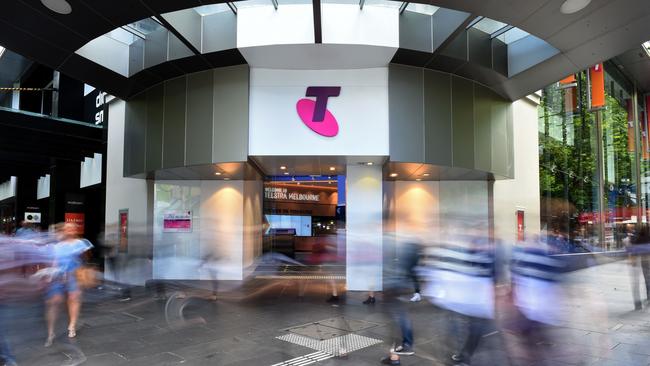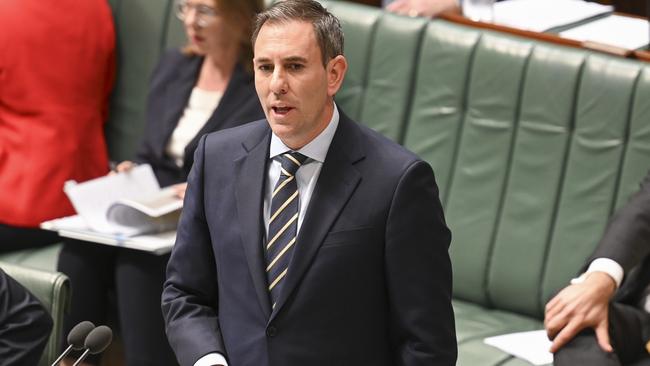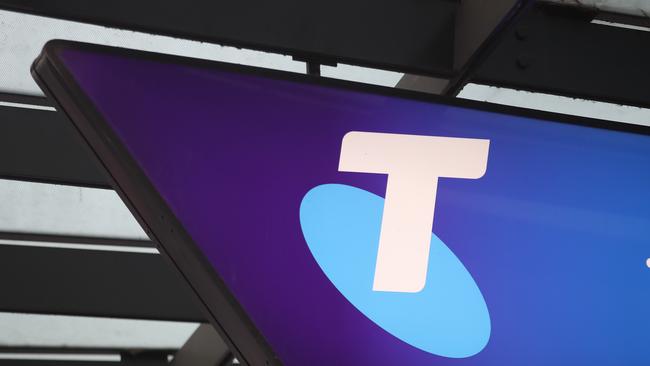Behind the big forces driving Telstra’s hand on job cuts
The telco’s move signals the era of ‘jobs hoarding’ across corporate Australia is finally reaching its end.

Business
Don't miss out on the headlines from Business. Followed categories will be added to My News.
Telstra has become the first of Australia’s big corporates to undertake massive cuts partly in response to surging costs and slowing economy, marking an end to the “jobs hoarding” that until now has kept the employment market so tight.
The telco’s decision to axe 2800 workers across the business should set alarm bells ringing loudly in Canberra as other big employers will be running their eyes over surging costs, particularly with the outlook for inflation set to be higher for longer.
Treasurer Jim Chalmers should hope he has got his forecasts right by claiming his big-spending budget, handed down just a week ago, isn’t adding to inflation in the economy. Any more inflationary heat will add to pressure on corporate costs as a time when revenue growth is slow.

Through the cuts, Telstra boss Vicki Brady is attempting to get ahead of the drawn-out economic slowdown, but it is the lag effect of rising costs that are the bigger worry. And the message is that if Telstra is feeling the pinch on higher costs, such as energy, wages and the cost of doing business, other corporates will be feeling it as well.
In Telstra’s case it is a real cause for concern as the cuts, representing nearly 9 per cent of the workforce, come on the heels of a recently finished major restructuring effort in which thousands of jobs went.
Brady’s predecessor, Andy Penn, axed 8000 staff as part of his T22 comprehensive rebuild of Telstra. Brady made her own extension to the program (dubbed T25), which delivered several hundred more job cuts into the pool, although her program was mostly around driving revenue growth.
Across the two – T25 is nearing completion – Telstra would have taken a collective $3.2bn worth of fixed costs out. The cost cuts outlined on Tuesday would form part of the T25 savings target of $500m.

The question Telstra’s workers will be rightly asking is what did management miss
– or fail to anticipate – in the previous programs? However, this is the lesson for other companies. Penn’s program was developed through 2018, and the T25 plan came together in September 2021.
In both cases the outlook for inflation was vastly different, and few had anticipated inflation in Australia would peak at nearly 8 per cent in less than a year and push to near double-digit levels in the US and Europe. The wider scope of Telstra’s latest job cuts show how tough it has been to get on top of rising day-to-day costs.
For a business like Telstra, inflation often takes time to flow through, particularly as supplier contracts are reset and annual wage rises are given. So even with inflation coming off its peak, it will still flow through Telstra’s expense line for some time yet. Looming on the horizon is a new round of wage talks with unions, as the current agreement is set to expire at the end of September.
Brady on Tuesday said savings were needed in order to make investments needed to support the explosion in demand for data over its networks.
She said the cuts were occurring “within a dynamic environment, with an evolving competitive landscape, rapid advances in technology, changing customer needs, and the ongoing inflationary pressures facing all businesses”.
Tech disruption
The economy isn’t the only force buffeting Telstra. There is a structural shift hitting the company’s enterprise and networks unit that sells telco services to big businesses. This has already happened to the telco’s old copper wire business long ago and that has since been handed over to the NBN.
Here, the shift is on at a rapid pace as corporate clients move to web calling and cloud-based services. Indeed, many companies are ditching their own internal networks for cloud services, and this was once a reliable income stream for the telco.
Brady recently warned that “negative trends” in networks were accelerating and starting to hit earnings. Tech giants like Google, Microsoft and Cisco are also making inroads into Telstra’s market. Rival Optus, which also has a large enterprise decision, will be feeling the same pressures.
Much of the heavy lifting in the restructuring will take place across Telstra’s enterprise business. Demand for network services from professional services clients started falling late last year, and the slowdown has continued into this year. The challenge for Brady will be unpicking what is technology challenge from the slowing economic demand.
In February, Brady told investors: “There have been structural changes under way in terms of (direct line cable) and calling, but this professional services decline we’ve seen does appear to be cyclical.”
Brady is centralising customer sales and services for enterprise. Costs too will be slashed on the Telstra Purple, the tech consulting arm for big business that competes in a crowded market against big global tech names in increasingly the big four audit firms.
Part of the latest cuts for Telstra follows the playbook that worked so well in other divisions: that is, taking a knife to the amount of products offered by the telco. In this case, she is slashing the number of network products by two- hirds. Penn’s T22 program famously slashed the number of consumer and small business products on offer to just 20 from 1800. This allowed the business to operate with a fundamentally lower cost base.
The cuts come days after Telstra outlined plans to roll out AI across every part of its business to lift tech productivity and put its user experience on par with the major technology players. However, the telco has been at pains to not link AI to the job cuts.
Brady argues that Telstra’s business is evolving with the needs of big corporate clients. While direct calling may be slowing, Telstra is getting into cloud services in a big way and is also eyeing a shift into broader data centre offerings. Last year’s $270m acquisition of Melbourne-based cloud consulting business Versent was a step in that direction.
The Reserve Bank expects the nation’s unemployment rate to shift up to 4.3 per cent from around 4 per cent currently, and that the rest of this calendar year is set to be the riskiest moment in Australia’s economic slowdown.

So far, big business has been prepared to trade off their profit crunch by “hoarding” workers; that is, holding on to staff longer than necessary.
Many employers were caught exposed coming out of the Covid-19 pandemic and were forced to pay a premium to secure good staff in an exceptionally tight jobs market. Some – particularly in hospitality or services – had to cut back business for the lack of workers.
Think of airline Qantas that suffered a reputational battering as it struggled in the post-Covid restart. Labour hoarding works for so long, but unless staff are fully utilised this is another reason behind Australia’s sagging productivity.
Telstra swung the axe on jobs as minutes released by the Reserve Bank from its board meeting of earlier this month show the central bank had discussed an interest rate rise, given there was “somewhat less slack in the economy than previously expected”. It opted to keep the cash rate on hold, but it shows risks continue that Australia may not yet be through the rate hiking cycle.
The RBA’s board had noted “decisions to hoard labour” was a big factor in the employment market being so tight. However Telstra’s move means the hoarding era could be fast drawing to an end.
johnstone@theaustralian.com.au
More Coverage
Originally published as Behind the big forces driving Telstra’s hand on job cuts




